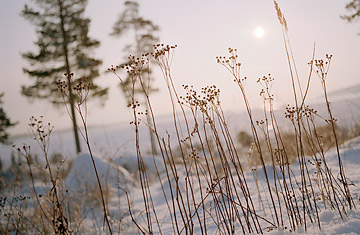
Most of the fallout from climate change is likely to be disruptive, to put it mildly. It's hard to put a positive spin on rising seas, increased drought and wildfires, shrinking water supplies and more acidic oceans. For the plants that form the very foundation of the food chain, though, an argument can be made that both global warming itself and the rising carbon dioxide levels that cause it are actually a good thing. CO2, after all, is essential for the photosynthesis that most plants depend on for nourishment. And as winters get milder and shorter, plants will have longer growing seasons. More food plus more time to eat it seems like a recipe for very happy vegetables.
But the story is a lot more complicated than that. "There's a big range of very powerful interactions in nature," says Chris Field, director of Global Ecology at the Carnegie Institution at Stanford University. "It's very risky to make strong projections based on single-factor explanations."
The latest evidence for that assertion comes in a study just published in the journal Forest Ecology and Management, in which Finnish researchers looked at how the northern forests will respond as the growing season gets longer. In the current climate, says lead author Anna Kuparinen, of the University of Helsinki, pine and birch trees in the northernmost parts of Europe are stunted, in part because they have less time to grow each year than their more southerly counterparts. They've also evolved mechanisms that protect them from the harshest cold. "They actually stop growing before the frost comes," says Kuparinen.
If the frost starts coming later, though, she says, they can't un-evolve overnight. "The current forests won't immediately start growing taller and stronger," she says. Eventually, the evolutionary process will catch up, as new seedlings without the frost response take over. "In principle, however," says Kuparinen, "this process will take a long time. The rate of evolution is slower than the rate at which climate will change." The forests would thus get no benefit, remaining stunted until seedlings without early dormancy genes can take root and take over.
And this is only the latest in a long line of modeling studies and experiments that show how complicated the climate-vegetation connection can be. When you double the CO2 in greenhouses where wheat or soybeans are growing, for example, the plants grow bigger by an average of 20-40%. But things get messier when scientists add CO2 to plants growing in real-world conditions. In a set of experiments called the Free-Air Carbon-dioxide Enrichment project, or FACE, investigators have been introducing CO2 into the air in experimental fields and forests around the world. The result is that some plants do grow bigger, says Field, "but an increase in growth doesn't necessarily mean an increase in the plants you want." At Duke University, one of the sites used in the FACE program, he says, "the pine trees grew more, but poison ivy grew a lot more. In our own experiments, the plants most sensitive to carbon enrichment tend to be the weeds."
Beyond that, says David Lobell, a Stanford colleague of Field's and his co-author on a major 2007 review of how plants and climate interact, "while there's pretty clear evidence that CO2 helps plants, there's plenty of debate about how much it helps." One reason is that plants depend not only on carbon dioxide for healthy growth, but also on water and other nutrients. Increase CO2 without increasing the other factors, and you can get plants that are bigger, but relatively deficient in, say, nitrogen — meaning insects may have to eat more of each plant to stay healthy themselves. Some FACE experiments look at the effects of variations in rainfall and nutrients as well as CO2. "Surprisingly," says Lobell, "you get different answers when they vary one at a time than when they vary together. It means there are a lot of interactions between the factors."
Climate change will, moreover, lead to different effects in different parts of the world. "In northern areas," says Lobell, "you'll see an expansion of the growing season" — which, if the Finnish study is correct, won't necessarily help forests, but could be good for crops, since you can deliberately plant seeds that are suited to long summers. But in arid parts of the tropics, he says, where plant growth is limited by the availability of water, more frequent droughts could make things worse. "Large parts of the world," says Field, "are already at the warm edge of where things like to grow."
In principle, plants can shift their ranges as the climate changes. But as Kuparinen and her colleagues are only the most recent to note, that shifting won't necessarily keep pace with a shifting climate. "In general," says Field, "we don't have very good understanding of the mechanisms that allow plants to move around on the landscape." Current estimates, he says, are based largely on studies of ancient ecologies. "But our models are mostly not validated for the modern, human-dominated environment."
In short, says Field, "we've got a huge number of studies that have given us important insights about how plants will respond to climate change." But there's even more he and his colleagues don't know yet. And that means that any straightforward conclusion about whether climate change is good or bad for plants is by definition extremely premature.
